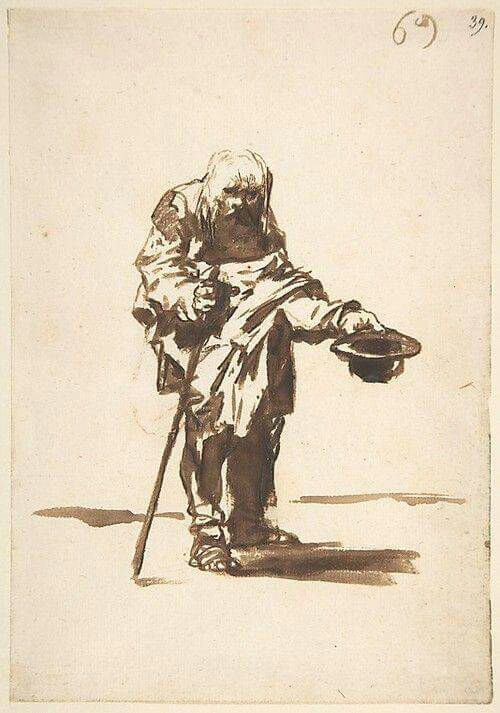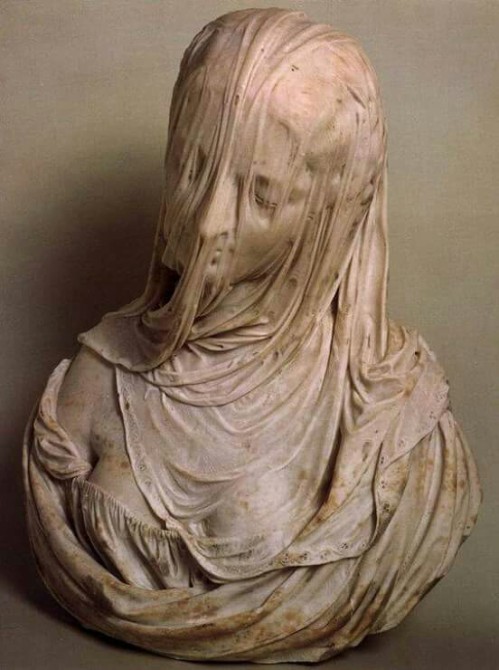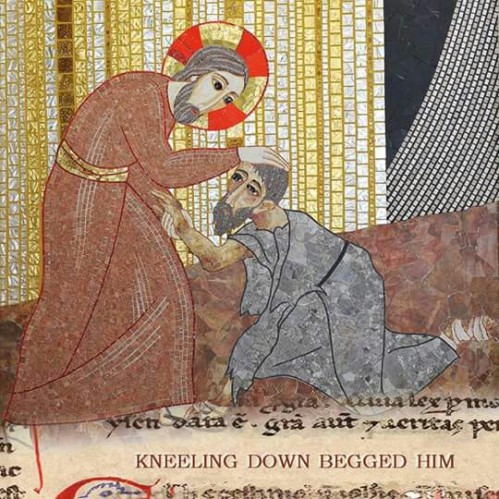
Happy Sunday from Venice!

Beggar with a Staff in His Right Hand Goya (Francisco de Goya y Lucientes)
Posted in Uncategorized
https://en.m.wikipedia.org/wiki/William_Randolph_Hearst_Memorial_State_Beach?wprov=sfla1
William Randolph Hearst Memorial State Beach is located near the historic townof San Simeon alongCalifornia State Route 1, inSan Luis Obispo County, California, United States. It is named for newspaper magnate William Randolph Hearst (1863–1951), whose family is closely associated with the area.

William Randolph Hearst memorial State Beach is located in northern San Simeon, California directly below Historic Hearst Castlein San Luis Obispo county.William Randolph HearstState Beach or as it is locally known “The Cove” was once home to the Hearst Family newspaper empire, and was the hub of Trade and shipping in the area. Before the 1800s the land was known to be inhabited by the Chumash.However the known written history of this beach begins way back in the mid-1830s when mission San Miguel was built, and by the early 1850s a small Portuguese whaling village had been built on the peninsula jetting out into the sea. Over the course of ten years, the small village managed to hunt down some three hundred and seventy whales though records of what type of whales was not kept it is assumed the majority of the whales were gray and humpbacks as these are the whales that are commonly spotted in the area. This village was short lived, because only ten years after it was built a severe drought caused the town to move to find fresh water. George Hearst Bought nearly fifty thousand Acres establishing the ground work for Williams Empire. The Hearst Family owned all the land as far as the eye could see from their castle until the early 1950s when the family donated a huge section of land to the state and sold miles of shore line to be used for public use. If you visit the beach today the pier George Hearst build in the 1800s no longer exists, but a new on was built in the 1900s just a few hundred yards down the beach that now stands in its place. now the beach is a California state beach.

William Randolph Hearst memorial State Beach is a quiet place with an abundance of wildlife and nature that can be easily viewed. Hearst Memorial State Beach gives visitors the opportunity to hike, swim, fish and beachcomb. A popular beach spot, this protected cove also offers visitors pier fishing as well as kayak fishing, but there is no large boat launch from the beach. Fishing licenses are not required when fishing from the pier but limits are enforced. The beach has a variety of outdoor activities including, kayaking, kayak surfing, paddle boarding, slack lining, hiking, fishing, andswimming. though kayak surfing is becoming more popular along the beach the water is mostly shore break and therefore it is difficult to surf on a normal surfboard. Located on the beach is a small kayak shop, Sea For Yourself Kayak Outfitter, shop which provides kayak, paddle board, bike, and other beach gear rentals. The most popular is the kayak tour, nearly every day around ten a group of people can be seen launching through the waves and embarking on a two and a half hour tour led by local business owner, Cubby, who has spent nearly ten years exploring and researching the cove and its history. The beach has more than initially meets the eye. Sights Include caves underground, beaches, arches, and an abundance of wildlife. different types of wildlife that can be seen in the cove over a year include but are not limited too, Gray whales, Humpback Whales,Bottle nose dolphins, sea lions, harbor seals, elephant seals, otters, and northern fur seals. fishing from both the pier and by boat is also popular and common fish that are targeted here include but are not limited too rock fishincluding Ling cod, cabezon, vermilion rock fish, and gopher cod. Other fishes include halibut, thresher sharks, smelt, surf perch, and the occasional sting ray. There is also a peninsula that jets out into the ocean which is still Hearst property today, they do allow visitors to hike the path all the way out to the ocean. Just above the beach in the upper parking lot, there is a discovery center which provides information about the history and the local wildlife. Picnic tables, barbecue grills and restrooms are available.This day use area offers 24 picnic sites, 150 parking spaces, restrooms, water faucets, barbecue grill stands and easy beach access. Recreational activities include picnicking, swimming, fishing, boating, kayaking and sunbathing. including the kayak and boogie board concession in operation with equipment for rent everyday from ten till four thirty. The beach is day use only there is no camping or bonfires are allowed, and the gates will be closed just after the sun down.
Today William Randolph Hearst Memorial State Beach is a quiet beach that has an abundance of wildlife and nature that can be easily viewed. On any given day you can expect to see people kayaking or paddle boarding on the calm waters of the cove, or fishing the kelp beds. the beach is divided into two sections from the parking lot down to the water is all state owned and maintained beach, but the other half of the beach all the way to the peninsula is private property still owned by the Hearst family today. although it is private property the Hearst Family still allows anyone to come and enjoy the beach. The mission is still standing today along with the Hearst warehouse, and Sebastian which is now a small grill serving all grass-fed Hearst beef, but used to serve as a small general store in the 1800s. There are also two newer buildings on a small kayak rental shop, and the other a small nature and historic museum or discovery center. another common thing to do at the beach is to hike the point. San Simeon point which is still Hearst property today is covered in trees, and has small trails that go out along its edges to its point where on a clear day you can see the Piedras Blancas Lighthouse tower which was built in the 1870s and is still in operation today
San Simeon has a mild climate, but fluctuates day to day. During the summer the temperatures could be in the nineties, or as low as the fifties on any given day. During the winter the weather is usually mild with temperature hovering between the low forties and high sixties. On average San Simeon sees only around twenty inches of rain a year. Most days start with a layer of fog that burns off by mid morning. once the fog has burned off the historic Hearst castle can be see on top of the water.
Posted in Uncategorized
Posted in Uncategorized
Posted in Uncategorized
Posted in Uncategorized
Posted in Uncategorized

Bust of a veiled woman Antonio Corradini (1668 – 1752)
Posted in Uncategorized

Gospel of the Day (Mark 1:40-45)
A leper came to him and kneeling down begged him and said, “If you wish, you can make me clean.”
Moved with pity, he stretched out his hand, touched him, and said to him, “I do will it. Be made clean.”
The leprosy left him immediately, and he was made clean.
Then, warning him sternly, he dismissed him at once.
Then he said to him, “See that you tell no one anything, but go, show yourself to the priest and offer for your cleansing what Moses prescribed; that will be proof for them.”
The man went away and began to publicize the whole matter. He spread the report abroad so that it was impossible for Jesus to enter a town openly. He remained outside in deserted places, and people kept coming to him from everywhere.
http://www.vaticannews.va/en/word-of-the-day/2018/02/11.html
Posted in Uncategorized